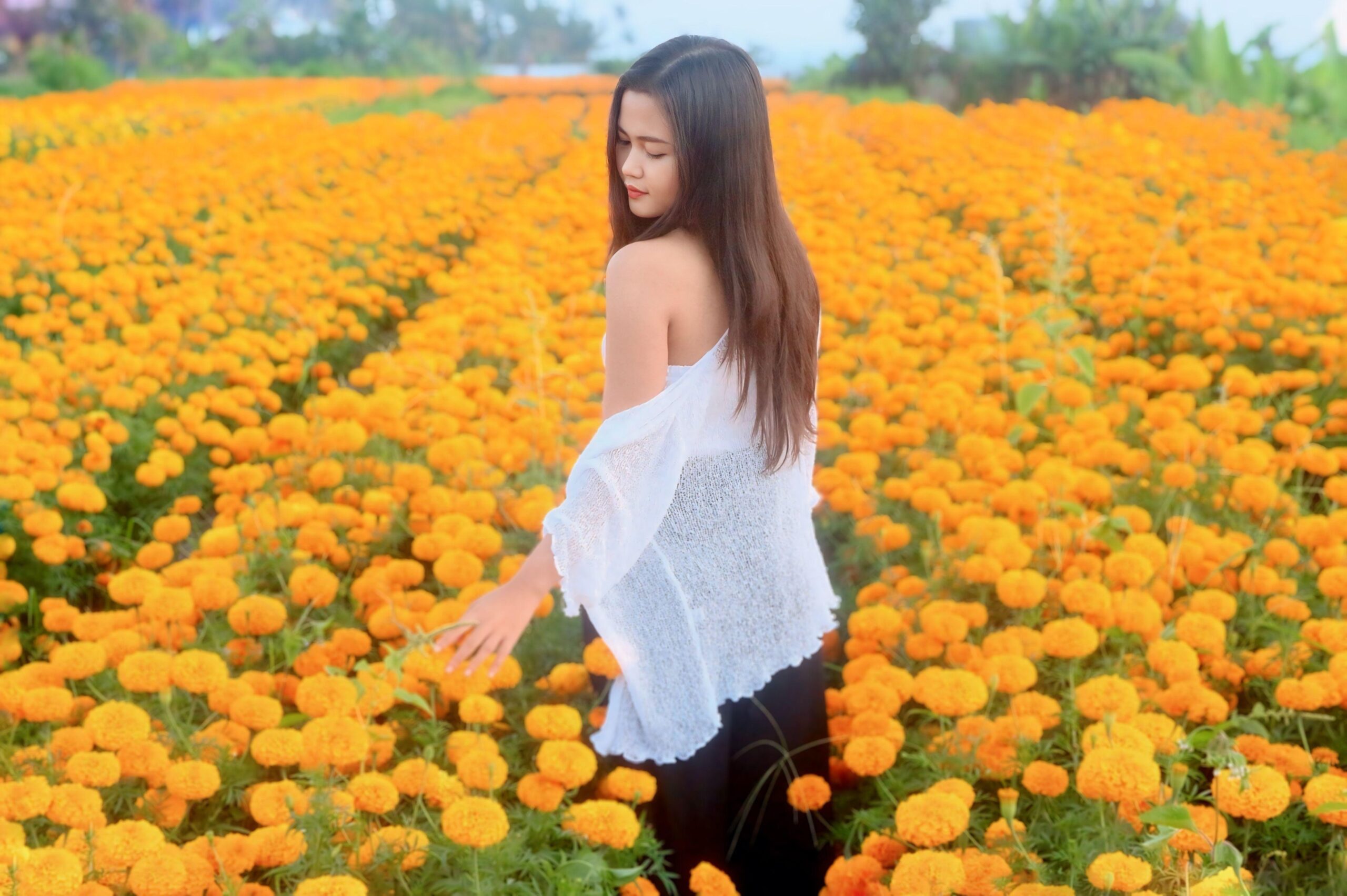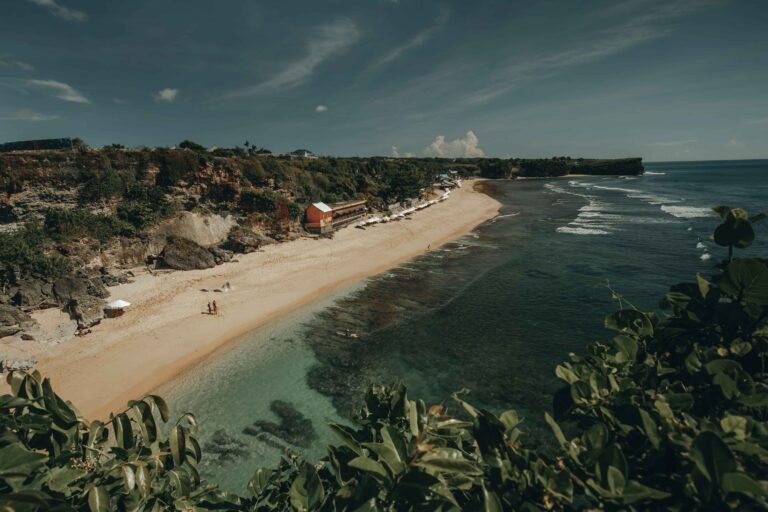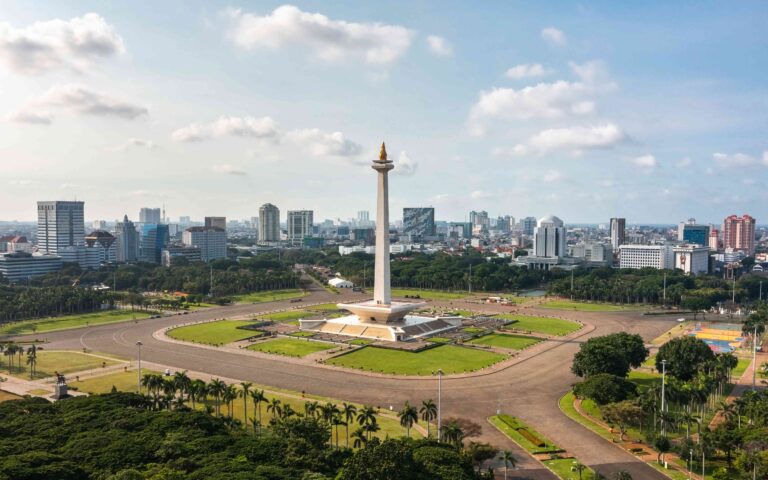The smallest regency, Klungkung, is not only one of the most important places to learn about the history and cultural significance of Balinese kingdoms, but it is also the gateway to the secluded tropical islands around Bali – Nusa Lembongan, Nusa Ceningan, and Nusa Penida.
Unfortunately, Klungkung is the least popular tourist destination, but with this guide, we aim to show how amazing this place is.
You are certain to have an amazing time exploring palaces, museums, and beaches in the area.
Where Is Klungkung?

Klungkung regency is located in East Bali, between Gianyar (Ubud), and Karangasem regencies (Amed and Candidasa).
It is a coastal regency and the only Balinese regency with the majority of the territory located off the island. Only about 30% of the regency sits on the mainland Bali.
Klungkung regency also includes three Nusa islands: Nusa Lembongan, Nusa Ceningan, and Nusa Penida, and a few tiny islands part of the Nusa islands group.
What is The Capital Of Klungkung?
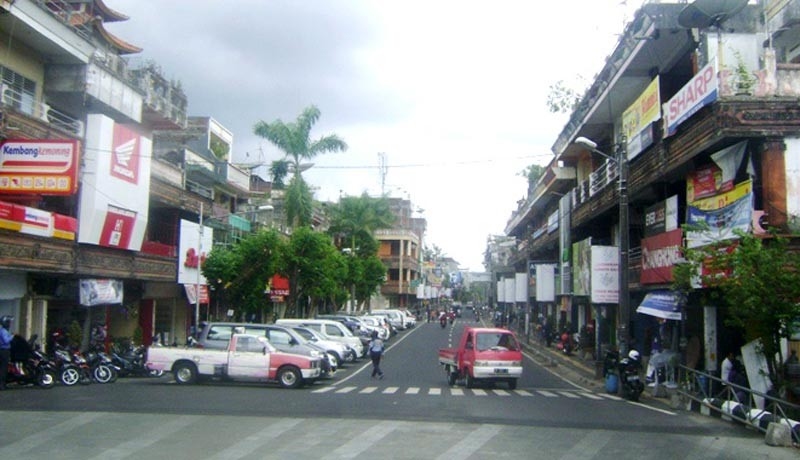
Semarapura is the administrative capital of the regency. It is practically synonymous to Klungkung town.
What Is The History Of The Klungkung Kingdom?
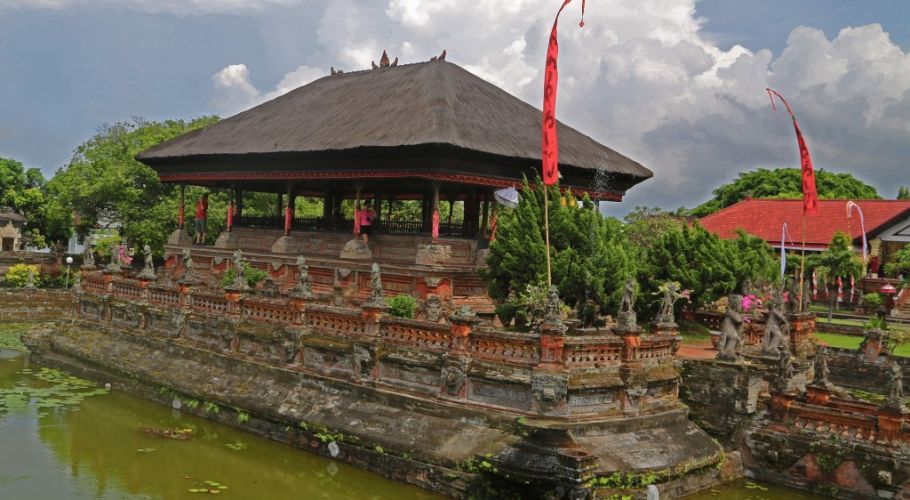
The Kloengkoeng kingdom, which has now become Klungkung regency, has a rich history and pre-existed the times when the Dutch East Indies reached the Balinese shore.
The Klungkung kingdom was formed around the 17th century when the court from Gegel moved here. It had peacefully existed as a local culture and art capital until the Dutch came with trading and military expeditions.
The kingdom rulers were considered the descendants of the Gods and the Balinese Rajas (kings) from the Gegel Kingdom – the only kingdom that ruled over the entire island and beyond – Lombok, Nusa Penida, and even East Java.
While there were a lot of conflicts between Dutch colonial authorities and Balinese, Klungkung was the last kingdom to fall.
It suffered the most during the Dutch military expeditions in 1849 and 1908, when the Dutch bombarded the territory, but the royal family and its followers, led by the king Dewa Agung Jambe, committed mass suicide to protest and show powerful resistance.
Only in 1938 was Klungkung reestablished as a Kingdom under Dutch rule, and the surviving family members returned to the newly built Puri Agung. Their rule lasted even when the Japanese occupied Bali during World War II.
Klungkung became a regency in 1949 when East Bali joined the Republic of Indonesia and accepted its formal administrative division.
What Is The Best Time Of Year To Visit Klungkung?
The end of the rainy season (April, May) and the dry season (May to November) offer the best weather conditions to visit Klungkung.
The rice paddies will still be green, the lush forest will provide shade and cool you down, and the deserted black sand beaches will offer a nice refreshing breeze.
Plus, it will be safer to take a fast boat to visit the Nusa islands as the waves won’t be as choppy as during storms (December to April).
No matter what time you decide to come, it is easier to explore this regency with a private car or book a tour, as it is quite far from South Bali and not as many tour operators take tourists here.
7 Places To See In Klungkung
Klungkung Palace (Puri Semarapura)
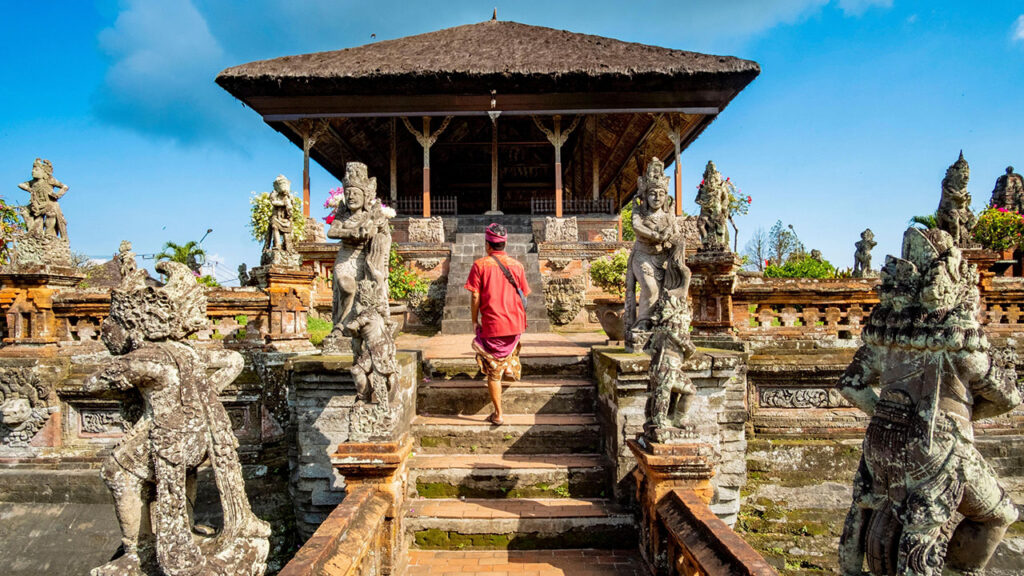
The original 17th-century royal palace was burned down by the Dutch in 1908, but some buildings once used by the royal family are still standing. Its original name is “The Abode of the Gods” or Puri Semarapura in Indonesian.
The Semara Pura palace complex was used as a royal court and residence. It is an amazing example of intricate Balinese architecture. Today, the most prominent remaining buildings are the Floating Pavilion and Taman Gili Palace (Kertha Gosa). We highly recommend taking a tour!
Kertha Gosa Court of Justice is famous for its painted ceiling – it is the last remaining example of traditional Balinese Kamasan style art influenced by wayang puppet theatres, depicting rows of different moral lessons from Hindu epics.
Next to it, you will also find Bale Kambang (Floating pavilion) surrounded by a lily pond, and featuring beautiful carvings and a traditional thatched roof. It was probably used for events and gatherings by the royal household.
Living members of the royal family live in Puri Agung Sempara – a complex built next to the former palace, which you can also visit and see the black and white photos of the family!
There is also a small Semarajaya Museum on the premises, which is included in the ticket. It overviews the history of Bali and has some art and curious artefacts.
Nyoman Gunarsa Museum
Nyoman Gunarsa is a famous local artist who now owns the Museum of Classical and Modern Art, where you can see his works and many other fantastic Balinese paintings.
Through art in this museum, you can get a glimpse of local life, culture, outfits, and religion. The majestic gates and a little garden around the territory add a nice, magical touch to the museum.
It is not maintained in the best way possible, but worth a stop! Plus, it is close to Goa Jepang Klungkung.
Goa Jepang Klungkung
Easy to spot – right where the big elephant sculpture is, this stop is often overlooked by foreign tourists, and few actually know that it’s here.
These caves and tunnels were built by the Japanese army during World War II when East Bali was under the control of Japanese forces.
Today, these caves are a bit creepy and inhabited by bats, and there are no active tours inside to learn more about the history of this place. You won’t spend more than 30 minutes here.
Puputan Monument (Monumen Puputan Klungkung)
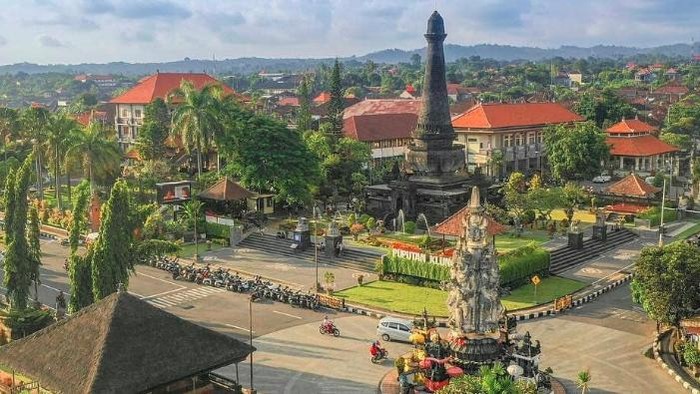
Easy to spot, this monument is at one of the main crossroads in Klungkung town, right next to the royal palace and Kertha Gosa.
Puputan is the ritual suicide that the royal family and local Balinese elite performed here in 1908 to show Dutch forces that they would rather die than surrender.
The monument looks like a big column and has a memorial at its base with a brief history of the events and some artefacts.
You don’t need a guide to explore it, as all the information is provided in Indonesian and English. However, there is an entrance fee (about 50,000 IDR or 5 AUD) that you pay at the Royal Palace, and it grants you free access to the monument.
Bat Cave Temple (Goa Lawah)
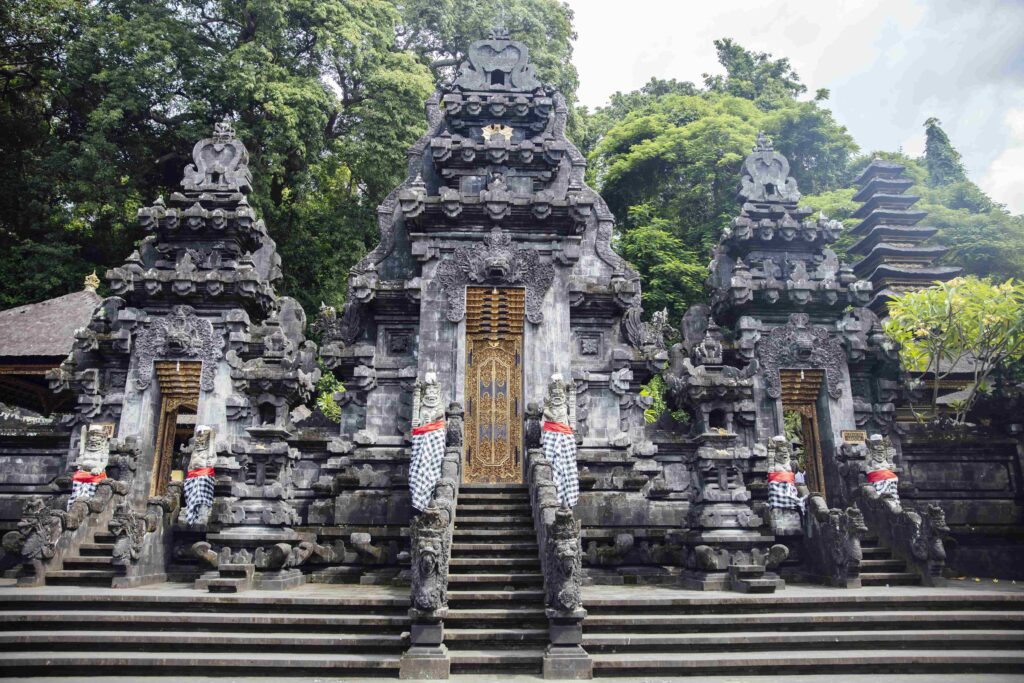
Goa Lawah Temple is one of the nine directional temples – the most important temples for Balinese Hindus.
It was built in the 11th century next to an ancient cave filled with more than a thousand wild bats that still inhabit it!
You can visit the temple for a small entrance fee, and if you can around sunset, the bats will be more active and you can see them flying out of the cave.
Note that you can’t enter the cave itself or touch the bats. There is also a huge bat statue by the beach in front of the temple.
Tirai Air Terjun Tukad Unda Waterfall
Not exactly a waterfall, Tirai Air Terjun Tukad Unda is actually a cascade formed by a dam on Tukad Unda river, and the spot is very close to the town centre.
Locals love to come here to chill, splash, swim, and take photos, and they lovingly call it a waterfall, so the name stuck.
Due to the tropical heat, the best time to enjoy this spot is sunset.
Pura Taman Sari Temple

A hidden gem, a Hindu temple of great cultural significance for Balinese kingdoms, and it is still standing intact!
During the Klungkung kingdom, this temple was a storage place for the weapons of the royal family.
It is very beautiful, but unfortunately, tourists aren’t allowed inside; you can still take a photo of the gates or do drone footage.
What To Do in Klungkung Regency
While exploring the whole Klungkung Palace complex is the first order of business here, there are a few more activities to add to your list.
Shop At Klungkung Market
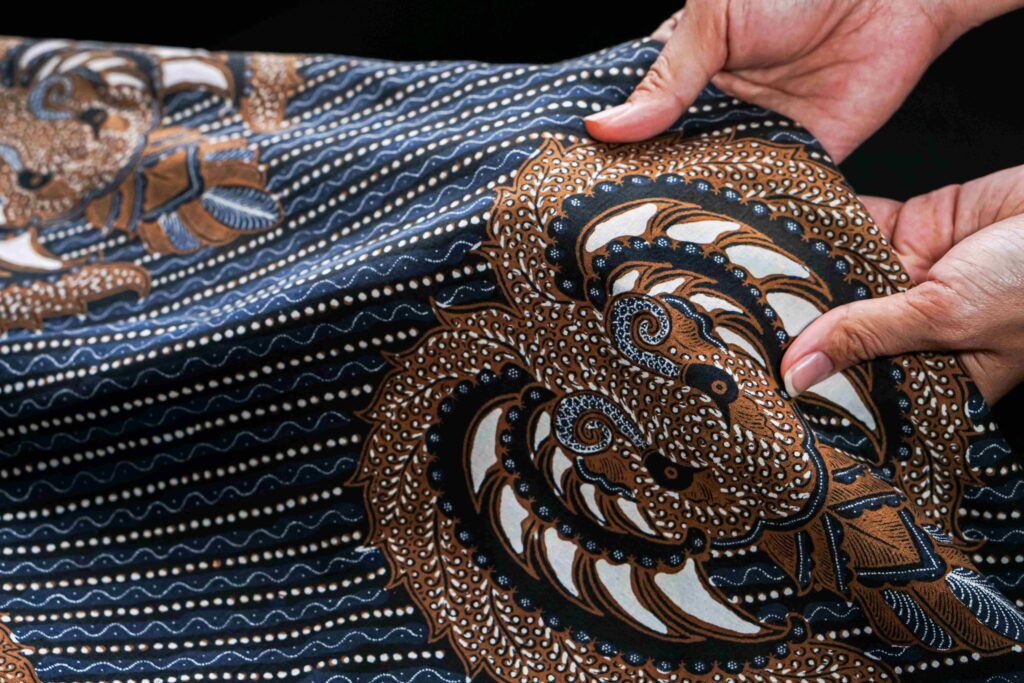
Klungkung market is the place to buy art, textiles (especially endek or handwoven sarongs), traditional gongs, and fresh local produce, as it has a strong agricultural tradition.
You can also buy jewellery, household items, and snacks here.
It is probably one of the cleanest and well-organised markets in Bali that tourists can visit. It has covered the main market to shop in the shade, and public toilets.
Plus, it is just a walking distance from the royal palace.
Explore Nearby Beaches
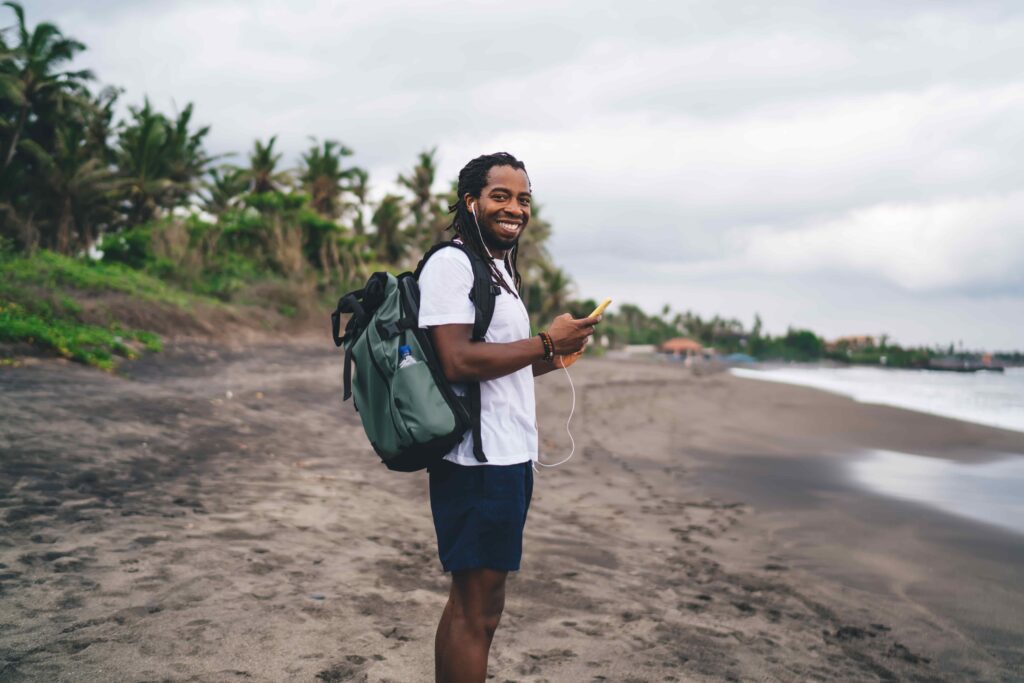
Black sand beaches overlooking calm waters of the Indian Ocean are what you get in Klungkung. Most beaches are completely empty – there are no sellers, sun beds, or people.
Locals love Pantai Batu Tumpeng for an occasional surf or jogging session, as well as Sedayu Beach, and Pantai Klotok Klungkung – all are large black stretches of sand perfect for a sunset walk.
Hunt For The Salt

Kusamba village is a coastal village famous for its sea salt production and fishing tradition.
They still do it all the old-school way, you can see the salt drying under the sun, taste it, and buy a few bags!
In Balinese culture, salt is not only an ingredient, but often used in rituals and ceremonies.
You will see a few signs on the road, but one good place to witness the process first-hand is the “Natural Salt by Nyoman Warta” farm near the Bat Cave Temple.
Head To Aan Secret Waterfall
If you love waterfalls and are looking for something special with no people and a portion of that untouched Balinese nature, Aan Waterfall is the best place to be, and it is close to Klungkung.
The trek is a combination of a slightly adventurous hike through a canyon and a leisurely walk in the jungle. Bring your water shoes!
Plenty of spots to take pictures, on the steps, in the canyon, over a bamboo bridge, or with the towering waterfall! After a heavy rain, the trail is tricky, so be careful.
Visit Paksa Village
Paksa is a village where you can witness something truly special. Here, Balinese get into a trance state and try to recreate ancestral battles.
It will be only possible to visit if you find a local guide or family willing to invite you, but it will be a once-in-a-lifetime experience, you’d never see in South or West Bali.
There are also a few hiking trails around, ask locals to show you!
Take And Art Class At Kamasan Village
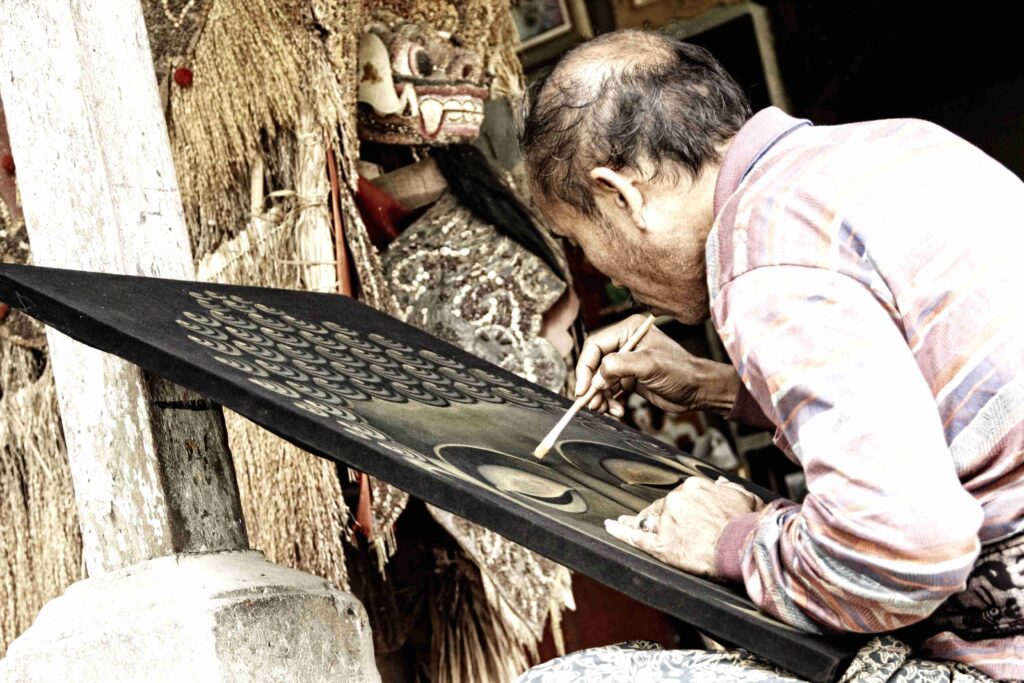
The Kamasan paintings decorating palaces and temples originate here! You can still visit a few artists’ studios to see how they create these unique paintings that have never had any foreign influence.
Sinar Pande Wayang Kamasan hosts workshops to teach this rare painting tradition, and you can customise a tote bag and take it home!
White Water Rafting

Tukad Unda is a beautiful river in Klungkung regency, and it is great for rafting. It has a 9-km route with multiple rapids, but they are all much smaller than the bigger rivers in Bali.
It will be perfect for families and tubing as well. The area around Tukad Unda Dam is a favourite local spot for swimming, too.
Nusa Islands: Nusa Penida, Nusa lembongan, and Nusa Ceningan
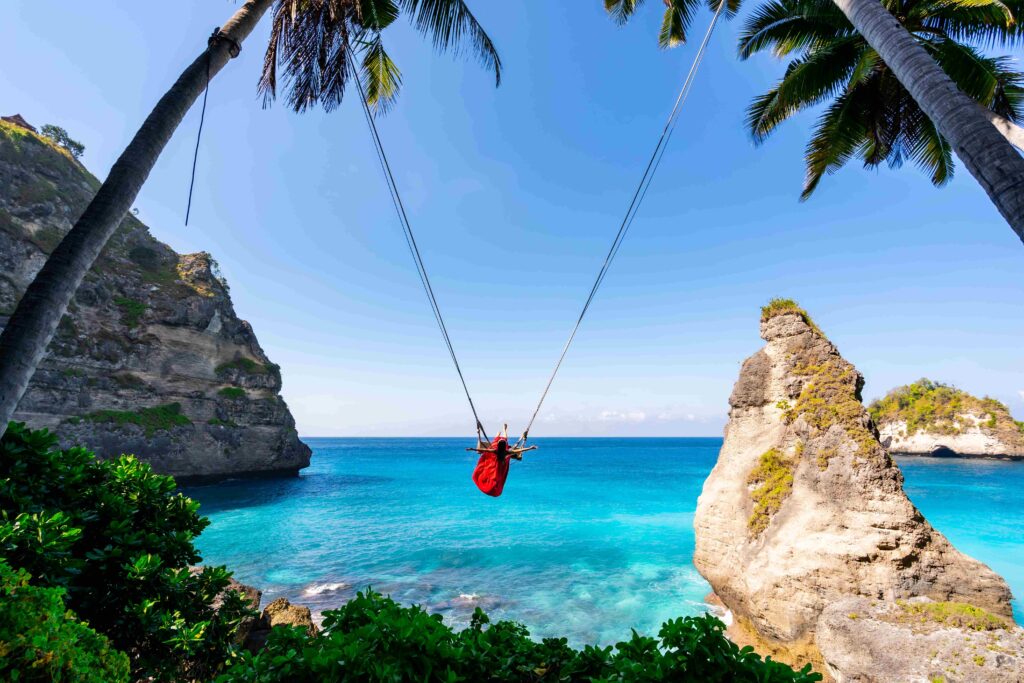
If you want to explore all of Klungkung, your trip can’t be complete without visiting the gems in the regency’s crown – the Nusa islands, each with its own vibe and natural attractions.
It is very easy (and cheap) to get to any of the three islands from Padang Bai harbour on a boat, and it will take only about an hour.
Nusa Penida
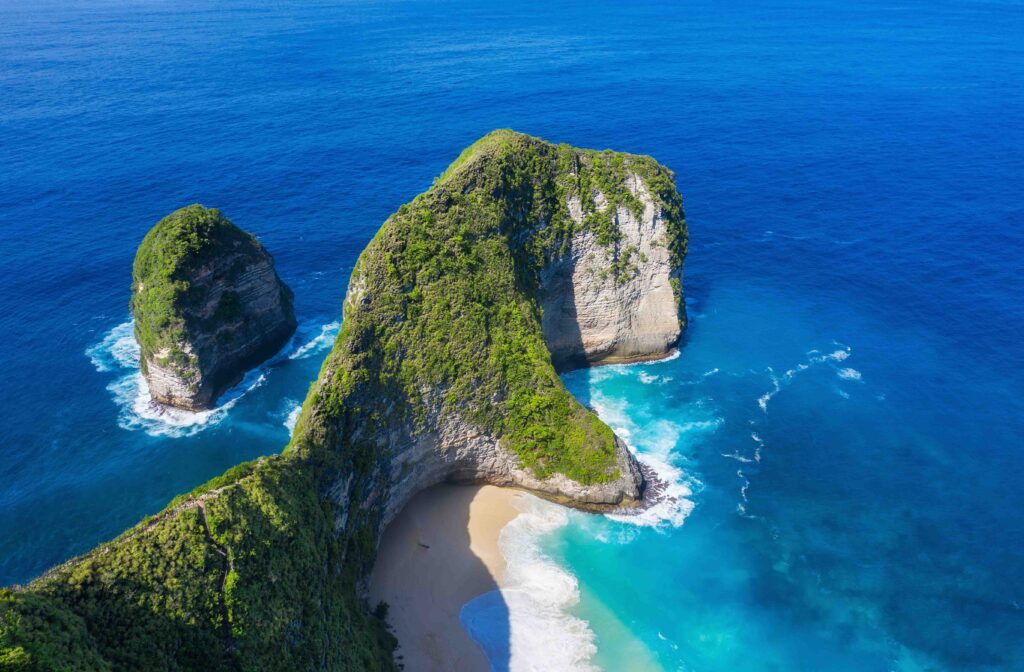
Funny enough, East and South Balinese kingdoms used to send misbehaving and breaking rules people to Nusa Penida, but now it is a lush island attracting lots of tourists on a daily basis.
It is the biggest of the Nusa islands and the greenest! You can visit Nusa Penida for just one day or stay a few nights to explore all the attractions, as the roads here are not the best and the commute takes most of your time.
Highlights of Nusa Penida:
Unique diving spots around Crystal Bay and Manta Bay to swim with Mola Mola and manta rays, myriads of tropical fish, and see the coral reef.
Picture-worthy beaches like Broken Beach, Kelinging Beach (famous T-Rex cliff), and Diamond Beach,
Lots of fresh seafood you can eat at affordable prices!
Beautiful remote resorts and treehouses for a perfect romantic getaway or honeymoon.
Nusa Lembongan
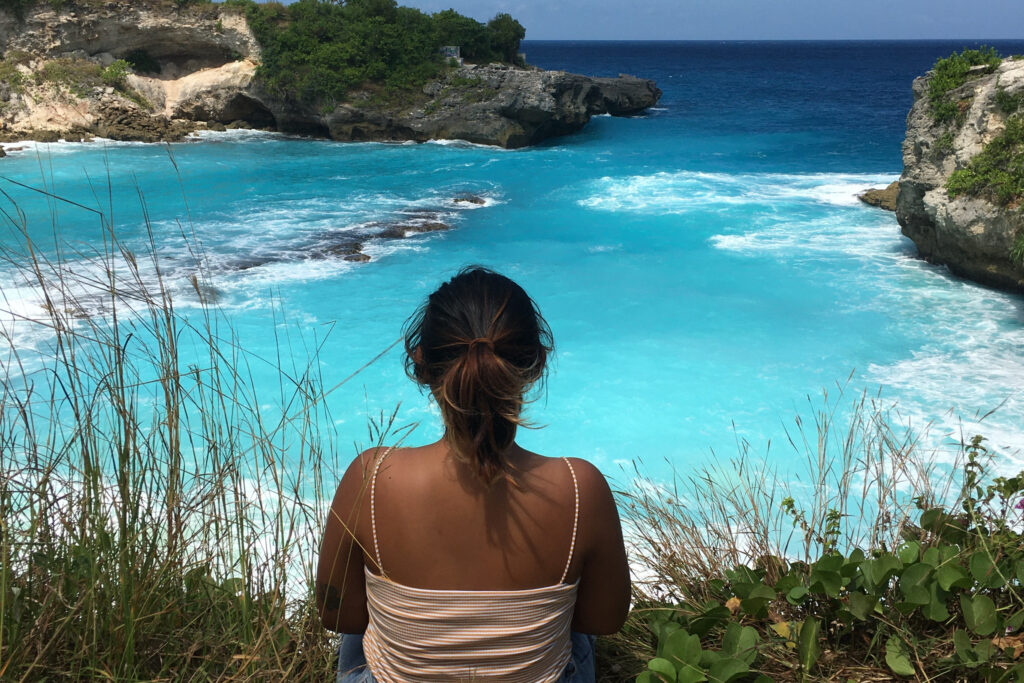
Surfing and white sand beaches in Nusa Lembongan are simply beautiful, and it is also a big seaweed production in Bali – a small, cozy island connected by a famous Yellow Bridge to Nusa Ceningan, another peaceful gem to relax or spend your honeymoon.
The best surfing breaks in Lembongan are on the west coast, and dozens of skilled local coaches will teach you how to catch these advanced waves.
If you are not a surfer, you can really indulge in diving and snorkelling in these turquoise, crystal clear waters.
Not in the mood for getting in the water? You can explore little hidden and not-so-much beaches around the island, with the top attraction being, hands down, the Devil’s Tears – spectacular and extremely dangerous waterblow splash over a volcanic cliff.
A Mangrove tour is also a cool and very interesting activity to do while you’re here – you will learn lots about these amazing trees, why they are in danger, and what the community does to help them grow.
Nusa Ceningan
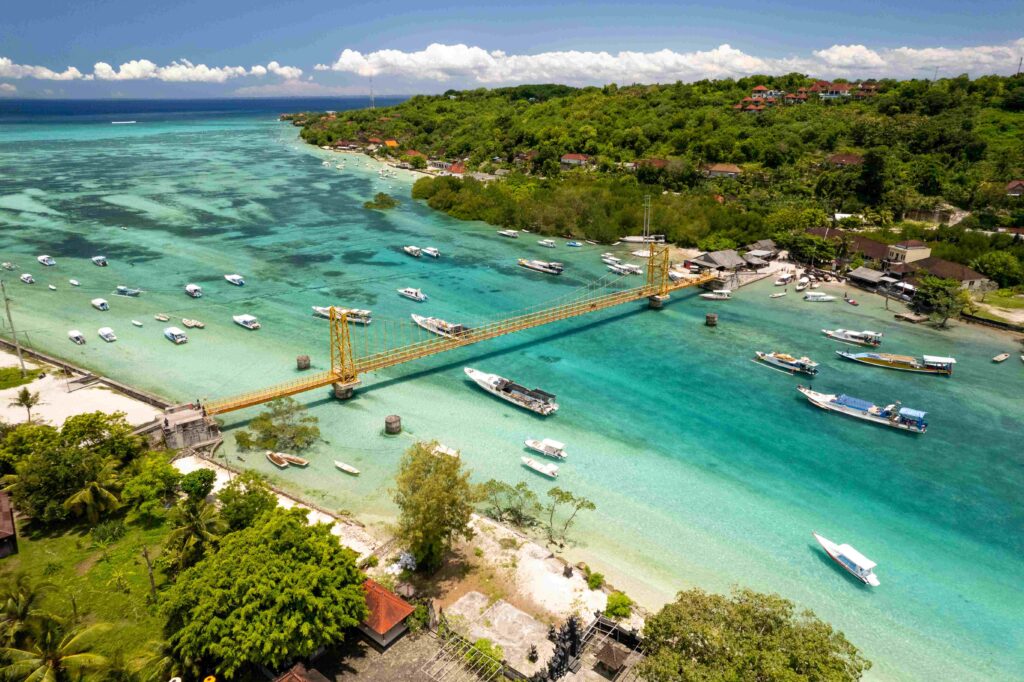
The smallest of the three islands, Nusa Ceningan, is tucked between Nusa Lembongan and Penida and offers a serene paradise for everyone who loves slow island life.
It is so close to Nusa Lembongan that you don’t have to worry about dinner options, but at the same time, far enough to enjoy your peace and quiet.
The main attractions of Nusa Ceningan are absolutely incredible sunset views in one of the oceanfront cafes on the west side of the island, the Yellow Bridge connecting it to Lembongan, and the Blue Lagoon cliff and water blow.
Where To Stay in Klungkung
There are a few hotels and many villas to stay in Klungkung regency, and it is a perfect destination to disconnect from the busy world and meet local life as it is, without risking bumping into many tourists.
Wyndham Tamansari Jivva Resort Bali
A big 5-star resort with private beach access and a swimming pool. You can stay in a hotel room or a private villa with a plunge pool.
Staying at this hotel, you can enjoy as much snorkelling as you wish and have spa treatments at the spa on site anytime you want!
Where Is It? Pantai Lepang, Jl. Subak Lepang No.16, Takmung, Kec. Banjarangkan, Kabupaten Klungkung, Bali 80752, Indonesia
Online: Wyndham Tamansari Jivva Resort Bali
Cegeng Lestari Guesthouse
If you’re looking for a very affordable accommodation surrounded by nature, this simple guesthouse is perfect for you.
Some rooms have amazing views over jungles, and the breakfasts and dinners at the property are very yummy, using fresh local ingredients.
Where Is It? Desa Cegeng Kertabuana, Kertha Buana, Sidemen, Karangasem Regency, Bali 80864, Indonesia
Online: Cegeng Lestari Guesthouse
The Secret Spot Villas
Amazing oceanfront villas where you can stay all by yourself if you’re lucky. The price is a bit higher than if you’re staying in town, but the place is much nicer too.
The pool is postcard-worthy, and the Indonesian food is on point.
Where Is It? CCG9+5RQ, Jumpai, Klungkung, Klungkung Regency, Bali, Indonesia
Online: The Secret Spot Villas
Bougain Villa
Another beachfront accommodation option with a spacious lawn, an amazing pool, and 5 stylish rooms.
This private villa is perfect for a group of friends up to 12 people or a big family. It also has a pool table, an option to have a private chef, and organising daily activities, including events.
Where Is It? Pantai Tegal Besar, Desa, Negari, Kec. Banjarangkan, Kabupaten Klungkung, Bali 80752, Indonesia
Online: Bougain Villa
Where To Eat in Klungkung
Sate Kambing Paksebali
When visiting Paksa village, you have to stop by this warung (local eatery) and try authentic goat skewers (sate kambing) or the Indonesian version of a goat curry.
A full lunch with a drink will cost just 50,000 IDR (5 AUD).
Where Is It? FC77+94W, Jl. Semarapura Kangin-Kusa, Paksebali, Kec. Dawan, Kabupaten Klungkung, Bali 80761, Indonesia
Warung Bu Lala
Cheap eats in the city centre to try local staples like chicken soup (soto ayam) with rice, fried rice (nasi goreng), veggie stir fry (cap cay), and crispy calamari.
The menu is big, and all the food is incredibly affordable.
Where Is It? FC54+P5H, Jl. Kresna, Semarapura Kangin, Kec. Klungkung, Kabupaten Klungkung, Bali 80761, Indonesia
Jiji Sushi Ramen
For a cheap, hearty, and creamy bowl of ramen, Jiji Sushi is the stop. The best part? A bowl is under 30,000 IDR (3 AUD).
They also have some deep-fried rolls for you to try.
Where Is It? F95W+GCR Near, Jl. Kecubung, Semarapura Kelod, Kec. Klungkung, Kabupaten Klungkung, Bali 80716, Indonesia
Dians Garden Bali Klungkung
An amazing Indonesian restaurant with more chic interiors than local warungs.
They serve a few Western dishes here too, including pizza, Chicken parm, spring rolls and other classics. We highly recommend trying the fried duck (bebek goreng)!
Where Is It? CCW5+JF8, Gelgel, Klungkung, Klungkung Regency, Bali 80761, Indonesia
Warung Secret Aan
Simple open-air cafe with rice fields views and Indonesian food. A must-have here is Secret LakLak cake.
Any food here is good as all cooked by the owner and his wife.
Where Is It? Aan, Jalan Pura Dalem Setra Kelod, Desa Kecamatan, Aan, Kec. Banjarangkan, Kabupaten Klungkung, Bali 80752, Indonesia
Boja Billiard & Coffee
For a cup of morning coffee, snacks, or to play billiards, head to Boja. It is right in the centre of town and has laid-back vibes.
Where Is It? Jl. Kresna, Semarapura Kangin, Kec. Klungkung, Kabupaten Klungkung, Bali 80716, Indonesia
FAQs
What Is Klungkung Known For?
Klungkung regency is famous for its traditional paintings and art frescos in the royal palace. The art is focused on Balinese Hindu legends and religious epics like the Ramayana.
What is The Smallest Regency in Indonesia?
Klungkung regency was the smallest kingdom and is the smallest regency in Bali now, covering just about 300 sq km and providing a home for 220,000 people.
Is Semarapura Worth Visiting?
Semarapura or Klungkung town is worth visiting if you love Balinese architecture, history, and would like to avoid crowds of tourists.
In previous centuries, Klungkung was even more prominent than other south Balinese kingdoms, and produced a lot of unique art and crafts.
Final Thoughts on Klungkung
Whether you’re heading to unwind in Amed or Candidasa or looking for your next adventure, Klungkung is a worthy stop on the East coast of Bali.
Plan a day tour to visit the palace and indulge in cheap Indonesian food, or stay in a beachfront resort for a few days – you will surely enjoy your time here.
Read more:
Kintamani: Your Guide To One Of Bali’s Most Underrated Spots
Your Ultimate Guide To Amed, Bali: Everything You Need To Know About This East Coast Hotspot

